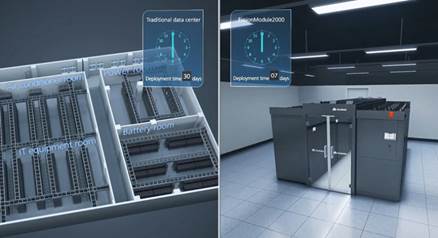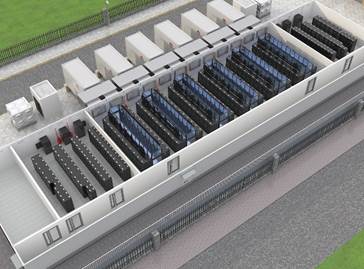Increasing
data demands are pushing IDC data centers to innovate and expand. With
technological developments shaping various industries, data consumption
continues to rise at an unprecedented rate. For data centers, the need to adapt
to these growing demands is becoming more critical. This article will delve
into the key drivers behind data growth, technological advancements in IDC data
centers, and scalable strategies that are being employed to handle escalating
data volumes more effectively and efficiently.

The Rising
Data Demands: What’s Driving the Change?
The Impact of
Cloud Computing on Data Growth
Cloud
computing has revolutionized the way data is stored and accessed. Businesses
and individuals can now store massive amounts of data off-site, reducing the
need for physical storage. This shift has significantly increased the volume of
data that data centers need to manage. IDC data centers are now essential in
providing the backbone for cloud services, ensuring that data is readily
accessible and secure.
The Role of
Big Data and IoT in Increasing Data Consumption
Big
Data and the Internet of Things (IoT) are transforming various sectors by
enabling detailed data analysis and smart device connectivity. Companies
leverage Big Data for insights, leading to the creation of vast data pools.
Similarly, the proliferation of IoT devices generates continuous data streams,
requiring scalable storage solutions. IDC data centers must evolve to
accommodate these large-scale data flows and ensure smooth processing and
storage.
How Social
Media and Streaming Services Contribute to Data Load
The
popularity of social media platforms and streaming services has led to a
substantial increase in data usage. Videos, images, and multimedia content
shared on these platforms constitute a significant portion of global internet
traffic. IDC data centers shoulder the responsibility of managing and
delivering this content efficiently. Ensuring minimal latency and consistent
user experiences are paramount, driving the need for advanced infrastructure
and robust data handling capabilities.
Technological
Advancements in IDC Data Centers
The Emergence
of Edge Computing in Data Centers
Edge
computing is a transformative technological advancement for data centers. By
processing data closer to its source, edge computing reduces latency and
enhances performance. IDC data centers are integrating edge computing to handle
real-time data analytics and reduce the load on central servers. This approach
not only improves efficiency but also supports the growth of IoT and other
latency-sensitive applications.
How AI and
Automation Are Improving Data Center Efficiency
Artificial
Intelligence (AI) and automation play pivotal roles in enhancing data center
operations. AI algorithms can predict potential failures, optimize resource
allocation, and improve cooling efficiency. Automation streamlines repetitive
tasks, reducing human error and operational costs. IDC data centers leverage
these technologies to ensure higher reliability and uptime, ultimately driving
better performance.
Energy
Efficiency: Sustainable Practices in IDC Data Centers
Energy
efficiency is a key focus for modern data centers. IDC data centers are
adopting sustainable practices to minimize their carbon footprint. This
includes using renewable energy sources, implementing advanced cooling systems,
and optimizing power usage. These efforts not only contribute to environmental
sustainability but also help in reducing operational costs, creating a win-win
scenario for both businesses and the planet.

Strategies for
Scaling IDC Data Centers
Modular and
Scalable Data Center Designs
To
accommodate growing data demands, IDC data centers are employing modular and
scalable designs. These designs allow for incremental expansion, ensuring that
data centers can grow alongside data needs. Modular data centers are
prefabricated units that can be quickly deployed, reducing construction time
and costs, and enabling data centers to rapidly scale their infrastructure when
necessary.
Leveraging
Hybrid Cloud for Enhanced Flexibility
Hybrid
cloud solutions offer a blend of on-premises and cloud-based resources,
providing flexibility and scalability. IDC data centers use a hybrid cloud to optimize workloads, improve data
redundancy, and increase overall efficiency. This approach allows businesses to
balance their data needs, leveraging the best of both private and public cloud
environments for maximum performance and cost savings.
Improved Data
Storage Solutions to Handle Larger Volumes
Enhanced
data storage solutions are critical for managing the growing influx of data.
IDC data centers are investing in advanced storage technologies like
solid-state drives (SSDs), high-capacity hard drives, and cloud storage. These
solutions offer increased capacity, faster data retrieval, and improved
reliability. By adopting these technologies, data centers can ensure that they
are well-equipped to handle the future data landscape.
Conclusion
IDC
data centers are at the forefront of adapting to escalating data demands,
driven by cloud computing, IoT, and multimedia consumption. By embracing edge
computing, AI, and sustainable practices, they enhance efficiency and
performance while addressing ecological concerns. Additionally, modular
designs, hybrid cloud strategies, and improved storage solutions provide the
scalability needed for future growth. As data continues to proliferate, idc data centers will play a crucial role in ensuring that data handling
remains robust, efficient, and sustainable.
